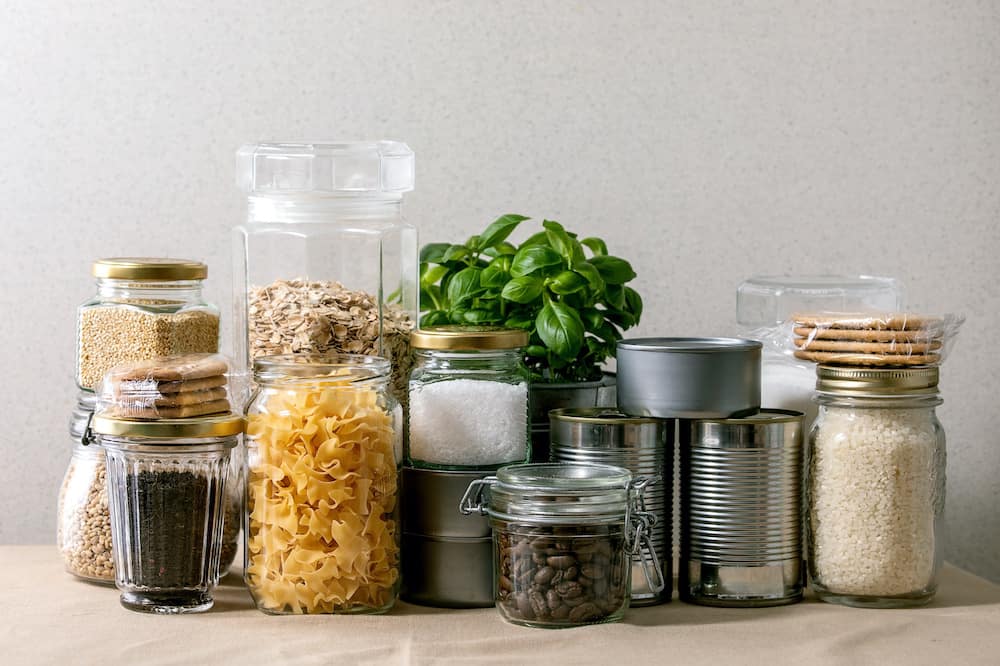In good times and in bad, I think it’s important to plan to have some survival food. Focusing on things we can control, like prepping and being prepared, means we avoid panic-buying and buying when costs are inflated.
Thinking for the future is also motivation to focus efforts on homesteading and sustainability. This includes gardening, preserving foods, and raising animals for their utility when possible.
Like saving money for a “rainy day”, the same is true about having some food to get you through some uncertain times. This can be helpful should someone become sick or injured, loose their job, have a short-term power outage, or maybe there is a more widespread, local or national problem.
Having even a bit of food can help quell anxiety. By preparing for the worst things that can happen, such as stockpiling the best survival foods, we are increasing our chances of survival significantly should the unexpected happen.
It also can help to save money as we can buy them as our budget permits, when they are on sale, etc. You won’t have to succumb to panic-buying.
I am going to talk about what survival foods are, what food is good to store long term, the ultimate survival food list that can get you started for your pantry, and more. I don’t think you can be too prepared when it comes to helping your family.
What Are Survival Foods?
In a nutshell, survival foods are food and drink items that are not easily perishable. You can store them for a long time without them going bad. People store them with the intention of using them in times of an emergency where you won’t be able to go out and buy supplies.
As a prepper or someone who wants to be more prepared, you have the option of preparing for a short-term or long-term crisis, or both.
What Are Good Foods to Stockpile?
If there’s one tip that we’d want you to take away from this, it’s this: Make sure that your food supply won’t go bad even with the absence of electricity.
This means that they must be able to remain edible and safe regardless of your home’s temperature and without the need for a refrigerator or a freezer. If you think that a food or drink item can last for an extended period even without electricity, then it’s a good item to include.
For you and your family, this may mean planning to store dried meat and jerky. Other protein sources include nuts, seeds, beans, lentils, powdered eggs, and powdered milk. While you can keep meat in a freezer, and you may want to have a backup freezer for this purpose, you shouldn’t rely on it.
Consider also how much space things occupy. An example is storing tea leaves or tea bags instead of already-bottled tea.
Consider storing things as unprocessed as possible. For example, coffee beans will last longer than already-ground coffee. However, you will be sure to have a coffee bean grinder and a way to power it should you not have electricity. Consider buying a manual coffee bean grinder if you don’t have one.
Being even a little bit prepared is better than nothing. I am going to list down the best survival foods in a bit, so keep on reading.
How Long Will Canned Food Last?
The moment you’ve heard about food items that can last for a long time even without a fridge, the first product that probably came to mind is canned food.
How long do canned goods really last? In general, canned food lasts for about 1 – 4 years. This will depend on the food. You also have to ensure you store them properly.
Avoid storing in the garage if you live in a climate with hot summers and/or very cold winters. A good range is between 50 – 70 degrees F, according to the University of Minnesota Extension.
However, with proper storage, especially in cooler temperatures, there’s a good possibility that you can extend the shelf life. This makes canned goods one of the best foods to stockpile for survival.
Be wary, though, and never forget to keep track of your inventory, especially when it comes to expiration dates. It’s wasteful to store food for worst-case scenarios and then find out that everything is spoiled.
Keep using your supply of canned goods for eating; don’t only save it for emergencies. Use the oldest cans first and replenish your storage supply with the new ones.
Survival Food List
For Flavor
The first thing that you want to think about is how you can flavor foods simply. Storing herbs and spices can make all the difference because they are relatively inexpensive. You can grow your own to preserve or buy them. They don’t take up a lot of room. Also, a little often goes a long way.
Another benefit to saving herbs and spices: If they are past their freshness date, assuming they have remained sealed without moisture, they won’t be unsafe to eat. They may not taste like they should and have their original flavor but they won’t be a hazard.
Seeds: Consider what grows well in your area and buy seeds for your favorite herbs and spices. Even one pack of seeds can be helpful if you have the ability to care for them.
Best Spices and Herbs for Preparedness
My top five are:
- Salt: Preserves food and enhances flavor. When kept dry, salt lasts indefinitely.
- Black pepper: Can last 3 – 4 years and still retain its taste.
- Garlic powder: Versatile for flavoring meat, beans, pasta and noodles, rice, other grains, vegetables and more. Lasts around 3 – 4 years.
- Dried oregano or Italian seasoning: Like garlic powder, it’s versatile. It can usually last for around 3 years.
- Cinnamon: Use to flavor oats, rice, and other grains. It can last 2 – 3+ years.
Other nice-to-have spices include:
- Bay leaves: Long-lasting and ideal for stews and soups. Can be kept for 1-3 years. In climate zones 8 – 10, bay leaf trees are easy to grow and low maintenance.
- Turmeric: Anti-inflammatory; lasts about 3 – 4 years
- Cayenne pepper: Adds heat to meat, grains, potatoes, and more. It can last for up to 3 years.
- Dried ginger: Lasts about 2 – 4 years
- Thyme: Versatile for various dishes. It’s somewhat easy to grow in hardiness zones 5 – 8. Lasts up to 3 years usually.
Cooking Oil
There’s a wide variety of cooking oil for you to choose from—coconut oil, avocado oil, corn oil, soybean oil, olive oil, peanut oil, and more. My household’s favorites are olive oil and avocado oil.
According to the USDA, oils will last for four months when stored properly. In my house, we store them in a dark cabinet without fluctuating temperatures. Because we only buy these two oils (olive oil and avocado oil) and cook a lot at home, we go through them quickly. Typically, we buy the oils from Costco.
When choosing which kind to store, consider allergies in your family. It’s best to choose one type of cooking oil that everyone can have.
Avocado Oil and Olive Oil Are What I Buy
For cooking and baking, we use avocado oil. It has a high smoke point of 500ºF which makes it safe for cooking. We also use it for baking because it’s tasteless and “better for you” than soybean oil and vegetable oils.
We use olive oil to make dressings, to top pasta, to dip bread in, and as a finishing oil to drizzle on meat, vegetables, etc.
Follow the best-buy dates on the bottle. When you buy them, keep them handy to use yourself in daily cooking. Always keep the newest ones to store. Don’t open it until you are ready to use it.
While cooking oils don’t have as long of a shelf-life as other foods, you can plan to use them first should their be an emergency. They provide fat which will be helpful as well. Making a basic bread and dipping it in olive oil can be something simple to prepare.
Butter
Buy regular sticks of butter as you usually do and consume them. Should there be an emergency, they will last in the fridge or freezer. However, I would not intentionally purchase sticks of butter for emergencies because you have to prep for the possibility of a blackout.
Canned butter (purchase it; do not attempt to can it yourself due to safety reasons) and powdered butter are the best choices.
- Ghee: High smoke point; can store for around 9 months if you don’t open it
- Canned butter: Red Feather canned butter can be stored for up to 10 years without being refrigerated. Experts strongly advise to not can butter yourself due to the risk of botulism; buy it instead.
- Powdered butter: Shelf life is 5 – 10 years if unopened.
Bacon Fat
Save bacon fat and store it indefinitely in your freezer or in the fridge for up to 3 months. Using bacon fat for cooking and even baking is a way to use up everything without wasting anything.
Honey
Honey is a versatile sweetener. According to the USDA, it will last for one year. After that, it should be safe to consume, however, the taste may change. From personal experience, I ordered small jars of organic honey. Even years later, it tastes good.
Another benefit to storing honey for emergencies is you can use it for first aid. Honey has antioxidant, antibacterial, and anti-inflammatory qualities. You can use honey as a topical ointment to help heal wounds and burns.
Store honey in a dark cabinet without fluctuating temperatures. The container should also be completely sealed, as honey readily absorbs extra moisture.
It’s natural for honey to granulate after a long time, and this doesn’t mean that it has gone bad. You can use honey granules as you would granulated sugar.
If you don’t want granulated honey, you can heat up the glass container of your honey in a pot of water, and let it simmer for a bit until the granules break down. Be careful not to let it reach its boiling state as boiling honey can kill its healing properties.
Pure Maple Syrup
Buying 100% maple syrup (no additives) in glass or plastic containers is an easy way to sweeten foods. Be sure it doesn’t say “imitation” on the bottle.
Salt
Here’s another ingredient that packs a lot of healing and cleaning properties—salt.
Wars have been fought to acquire salt, and we’re guessing that the demand for salt will continue in the future no matter what happens.
We recommend stocking up on iodized salt for cooking and canning salt for preserving more food in the future. Store salt in fully-sealed glass containers if possible.
You can keep salt in its original container and it will last for years. However, storing salt in plastic for a long time can cause the salt to absorb the chemicals present in plastic and contaminate your salt.
Meanwhile, the moisture in your salt will cause the metal to rust eventually. Finally, a cardboard container will let the salt absorb moisture. Just like honey, salt is very sensitive to moisture, as well.
Herbs and Spices
Dried herbs and spices are great to stockpile since they have a really long shelf life.
Aside from that, we also suggest that you keep the seeds of your favorite herbs stored to make sure that you will never run out of them, whether dried or fresh.
If you do choose to store your herbs and spices for long-term and future use, here are some tried-and-tested tips:
- Whole herbs and spices store longer than ground ones.
- You should make sure that they are completely dry before storing them.
- To remove excess moisture, use a dehydrator or simply air-dry your herbs by hanging them until they’re completely brittle and dried up.
- Keep them in a tightly sealed container placed in a cool, dry place away from sunlight.
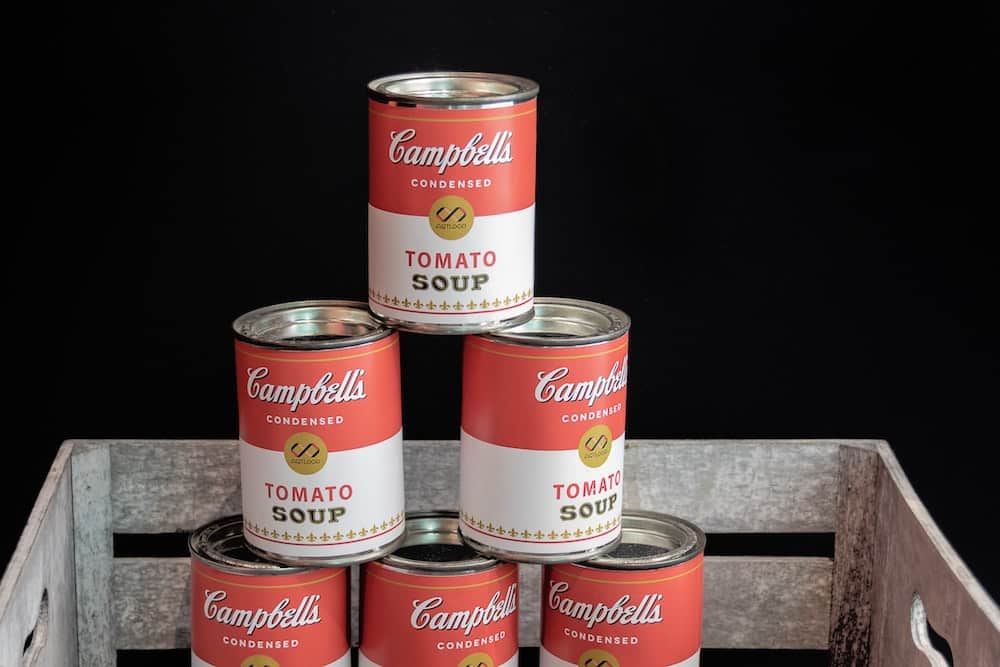
Canned Food Items
You’ve got the flavors covered, but where are you going to use them if you don’t have any other food supplies?
Well, that’s what we are going to list down next, starting with canned food items.
Canned foods should be part of every survival food plan.
Canned Veggies
You can always save the seeds of your favorite vegetables so that you can start your own vegetable garden when needed.
However, unlike herbs, vegetables take some time to grow, and you might not be able to wait that long for sustenance.
Hence, the best way to make sure that you have vegetables in your diet is to get canned veggies instead.
We prefer sweet potatoes and yams over the usual green beans because they pack more nutrients.
There are a lot of canned veggies for you to choose from, but it would be best to stay away from canned corn, which is most likely GMO.
Canned Fruit and Fruit Juice
Don’t forget to stock up on canned fruit and fruit juices, too.
They make the perfect ingredients for a delightful dessert, and they also offer a lot of vitamins and minerals.
Pineapple juice is our preferred choice since it has a lot of fiber and vitamin C.
Canned Meat, Poultry, and Seafood
For those who don’t get easily satisfied with fruits and veggies, we hear you; we’re carnivores ourselves.
Hence, take your pick from the vast selections of canned meat, poultry, and seafood available in the market.
We liked buying our canned protein in bulk since they are more affordable that way.
Just pay attention to their manufacturing date, and make sure that you get the freshest products as much as possible.
Here are a few more tips from the pros:
- Canned food should be kept in a cool, dry place.
- Be wary of rusted and bulging cans; they should be thrown away immediately.
- You would want to be careful that your canned food is put in a safe location where they won’t be dented or dinged.
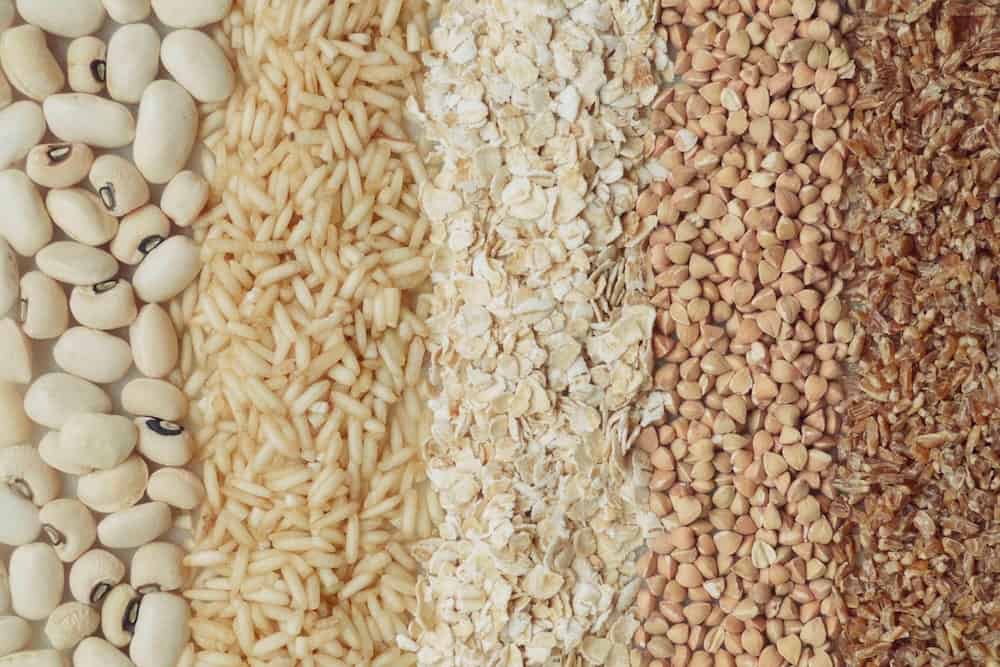
Carbohydrates
Since we are already talking about satisfying foods, we believe that there’s nothing more fulfilling than a big bowl of carbs, like rice, pasta, and oatmeals.
Rice
While brown rice is always the healthier choice compared to other types of rice, we don’t really recommend stockpiling brown rice.
That’s because brown rice requires more resources to cook.
Hence, we recommend choosing instant rice instead.
Use Mylar bags for long-term storage.
Pasta and Noodles
What’s great about pasta is that they usually lack moisture and fat content.
This means that they last longer compared to other food items.
There are different types of pasta to choose from.
We recommend stocking up on a variety of them so that you won’t get easily tired of eating them in the future.
Don’t forget Asian noodles, too.
Ramen and soba taste great, and they’re very heavy in the stomach.
When storing pasta and noodles, you can also use Mylar bags to keep them fresh for longer.
Bugs can burrow their way through the original plastic packaging of most pasta and noodles, so vacuum-sealed bags are also a good bet.
Storing them in glass containers is not recommended unless you have a way to remove the air within.
Potatoes in Planters: How to Grow Potatoes in Pots
Oats and Oatmeal
Oatmeal is very easy to cook, and they only require minimal water to be satisfying.
They also taste delicious, whether they’re cooked savory or sweet.
Just add some dried fruit, and you already have a mouthwatering breakfast.
We like getting oatmeal in bulk, stored in buckets.
Using Mylar bags is also an option.
Flour and Baking Essentials
You can’t stockpile bread, but you can certainly bake them with the proper equipment and ingredients.
Fortunately, flour and other baking essentials, like baking powder and baking soda, are easy to store, and they last long.
Flour can also be stored in buckets, but you need to put an oxygen-absorber inside to prolong its life.
Protein
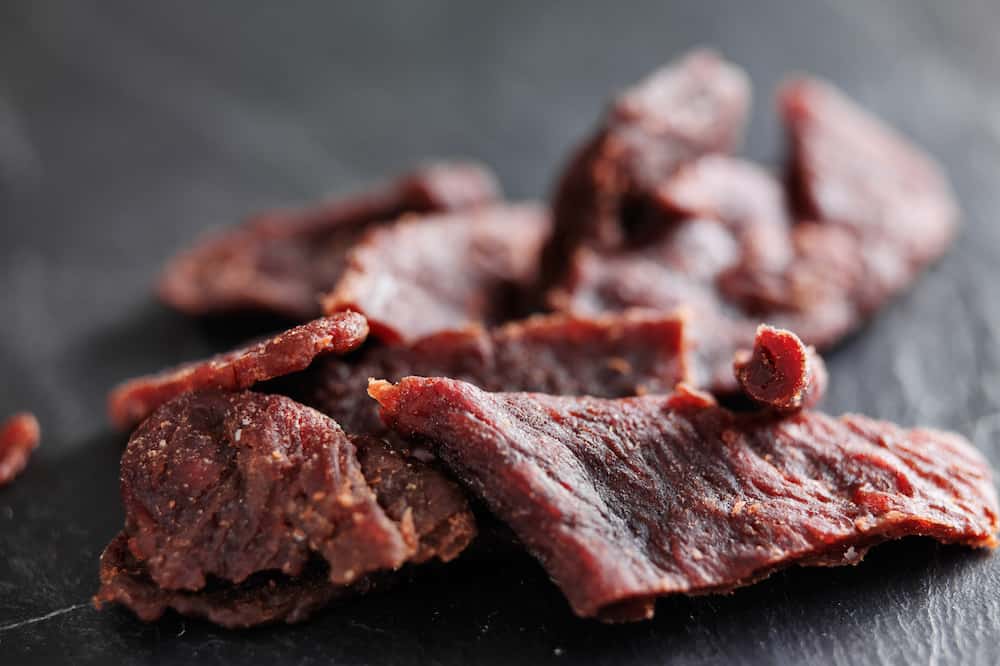
Now that we have our carbs all figured out, we can now move on to protein.
Here are some favorite protein sources for stockpiling:
Beans
When it comes to beans and legumes, the first thing that usually comes to mind is the canned form.
However, we actually prefer dried beans when it comes to long-term storage survival food.
To keep them for the long-term, we recommend taking beans out in the plastic storage that they usually come in.
Then, transfer them to sealable glass containers before placing them in a cool, dry place.
Dehydrated Meat
The first thing that comes to mind when we’re talking about dehydrated meat is beef jerky, but there are actually other choices, as well.
Jerkies come in different variants other than beef.
To store them for the long-term, keeping them in vacuum-sealed bags is your best bet.
You can prolong their life further by freezing the bags.
In the end, though, the best way to get meat post-crisis is to learn how to hunt.
Sweets
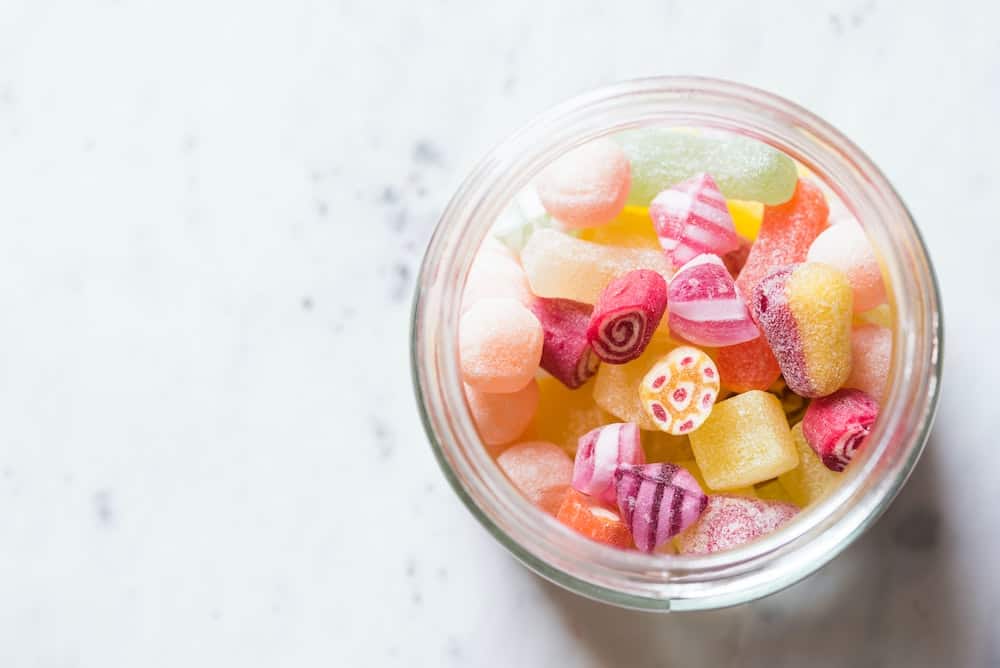
Now that we have the basics covered, let us now move on to food items that can provide pleasure, like sweets and drinks.
Jams and Jellies
You can always have butter with your bread, but don’t you think it’s great to have the option of eating it with jam or jelly, as well?
Fortunately, jams and jellies can actually last for a long time if you store them properly.
While you can always buy your jams and jellies from the store, we still recommend learning the art of canning them on your own.
Chocolate
If there’s one product other than salt that we think you can use as a bartering item in a post-crisis future, that would be chocolate. After all, who doesn’t like chocolate, right?
When storing chocolate, I think there are two great options: Dark chocolate and M&M’s.
Dark chocolate typically doesn’t contain milk; however, it can become cross-contaminated with it because equipment is often shared with milk chocolate production lines. Also, read ingredients because lower-quality dark chocolate often includes butterfat, vegetable oils, and other cheaper ingredients.
According to Harvard T.H. Chan School of Public Health, you should store dark chocolate in a cool, dry place around 65 – 70 degrees Fahrenheit. Keep it sealed in an airtight container.
When stored correctly, dark chocolate can remain good for up to two years.
Don’t store dark chocolate in the refrigerator. Otherwise, it may “bloom”. In chocolate, bloom is a white coating from sugar surfacing due to moisture. It doesn’t change the taste, just the appearance of it.
Second, you can simply get M&Ms. M&Ms last for around a year in a cool, dry place, out of the sun, until you open them and up to 3 months after you do. From personal experience, we saved M&M’s in the freezer for years, and they tasted great when we found them!
Candies
Now, onto candies.
You can always make your own candy with your stored sugar, but we know that it’s not going to taste like the actual candy we all know and love.
The good news is, as long as you get hard candy, you can actually store them in a sealed container, not subjected to any kind of moisture or heat.
With that, you have nothing more to worry about.
Survival Drinks
Since we are already talking about pleasures in life, what about alcohol?
We can get some ideas from wine collectors and connoisseurs on how to store them.
Still, as long as your alcohol is not fortified wine and cream-based, you can easily store any type of drink you want at room temperature.
Plus points if you can pull down that temperature lower.
Powered Drinks
You should consider powered lemonade or sports drinks.
They will last a long time in their containers.
You simply need to add water to mix.
Powered milk is another drink to consider.
Coffee and Tea
If you are a regular coffee or tea drinker, you will want to have these on hand. Keeping with routines, and caffeine, during crisis times will help bring a sense of normalcy.
Drinks are often overlooked as people think about survival food.
Other Essentials

Obviously, aside from food and drinks, you will need other essentials to survive a post-crisis scenario.
Here are the most important ones:
Vitamins
As preppers, we recommend getting your needed vitamins and minerals the natural way, which is through eating healthy food.
However, there is a way to store multivitamins and prolong their potency.
There are four factors you should look out for: oxygen, moisture, heat, and light.
As long as you keep your multivitamins stored with these in mind, they’ll be fine.
Infant Formula
As long as you keep your infant formula unopened, they can last until the expiry date set by the manufacturer.
Obviously, we don’t recommend giving your baby an infant formula that’s past its shelf life.
The best way to prolong your supply, even for just a little bit, is to rotate your pantry and regularly replenish it.
Fortunately, your baby won’t need it anymore when the time comes.
How Much Survival Food Do I Need?
Once you have determined the type of food that you want to keep, the next step to prepping is knowing how much you actually need.
It can be quite frustrating to know that you’re fully prepared for something only to find out later on that you haven’t really stored enough for the whole family.
There are food calculators online that can help you determine how much food you need per person per month or year, but as a quick guide, here’s a reference table.
| Carbohydrates (such as grains, pasta, and oats) | 400 lbs. |
| Proteins (such as beans and legumes) | 60 lbs. |
| Oil | 320 oz. |
| Sugar | 60 lbs. |
| Salt | 8 lbs. |
| Canned goods | 735 cans (two cans/day) |
How Much Water Should I Stockpile?
Now, let us move on to water.
You will need a gallon of water for drinking and cooking per person per day.
We’re guessing that your first impulse was, of course, to get bottled water from the store.
That’s great, as long as you don’t pile their boxes on top of each other, which may cause leaking.
Keep in mind that water comes with an expiry date, too.
This is a marker that tells you the best quality in regards to taste and drinking.
As preppers, we recommend learning how to sanitize your own water instead.
There are different ways to do so.
The most common is through the use of water purification products that come in liquid, powder, or tablet form.
In addition to learning how to purify water, you must also learn crucial water-collecting techniques.
This includes learning how to gather water from rain.
Finally, don’t forget to chart the nearest water source from your home.
You’re going to need water for bathing, cleaning, and washing purposes.
You might not consider hygiene as a priority post-crisis, but not falling into unsanitary and unhygienic circumstances is the best way to get sick.
We predict that medicine will be in very short supply post-crisis, so make sure that you still pay attention to your hygiene as much as you can.
Preparing Your Stockpile Room
With your shopping list ready, and now that you know how much food and water you’re going to need to store, the next step is preparing the room where you’re going to store your stash.
You must have the phrase “cool and dry place” memorized by now, but is there anything else you need to know?
Here are some tips:
Location
First and foremost, you have to decide on the area in which you wish to store the survival food.
For that, we suggest selecting the coolest room in your home.
This is why a lot of preppers choose to convert their basements into food pantries.
Light
The next thing that you want to do is to keep the windows closed; no light must seep in.
This is another reason why people prefer basements.
If you don’t have a basement, though, you can use thick drapes to cover your windows.
Temperature
You must also choose a room that is not prone to frequent temperature changes.
Having a smart thermostat in place is the best way to keep track of the temperature in your chosen room and maintain it.
Then again, at the very least, we recommend installing a room thermometer.
Moisture
Aside from a thermostat or a thermometer, you also get plus points if you have dehumidifiers installed.
These prevent any excess moisture inside your pantry.
With that said, any room that is prone to flooding and mold growth is a bad choice.
You must first deal with these issues before you put any food items inside.
Cabinets and Shelving Units
When it comes to deciding on where each item goes, we prefer putting light-sensitive food inside cabinets.
This is great for storing products that contain chemicals, as well.
For safety reasons, it’s even better if you can keep these cabinets locked or, at the very least, out of reach of children.
For instance, water purification tablets can easily be mistaken for candy if you’re not careful.
On the other hand, stacking food on top of each other is not a good idea, too.
Water bottles are not the only items that are prone to damage when stacked haphazardly; canned goods and buckets are, too.
Hence, you need to build a sturdy shelving unit to hold them safely.
Make sure that these shelves are secured to a wall and that they can prevent your supply from falling off and breaking even if an earthquake happens.
Accessibility
Don’t forget to consider the accessibility of your survival food items.
For instance, they must match the height of your family members.
If a member of your household has physical disabilities, make sure that they can reach the supplies easily, too.
Security
Finally, since we are already on the topic of accessibility, you might also want to consider keeping your entire food storage under lock and key.
You can also advise your family against sharing this information with other people.
While it’s always noble to help those in need, you also want to keep the needs of your family well-stocked and protected from looters.
It is simply up to you to draw the line on whether you’re going to help your neighbors when the time does come.
At the very least, with your food pantry locked, that choice won’t be taken away from you.
More Tips on How to Keep Survival Food
As a parting gift, here are even more tips on how to keep your supply safe, aside from the tips that we have already shared above:
Added Storage
What if the pantry’s space is not enough to hold the amount of food that you and your family need?
Those with the extra budget to spare can consider building a shed specifically for food storage.
However, we understand that it’s simply not an option for a lot of us, especially right now.
If that’s the case, then consider other unused space in your house for food storage.
For instance, you can try converting the space under your stairs as a secondary food pantry.
You can also utilize the space under your bed and other unconventional storage options.
Labels
Another tip to keep in mind is to properly label each of your supply.
The label must include when you have purchased the item and the expiry date.
This is especially crucial if you’re going to repack your food items.
Make sure that the labels won’t get easily removed or erased, as well.
In doing this, a Sharpie marker is going to be your best friend.
Equipment
To make sure that everything goes smoothly, we also recommend investing in the necessary equipment for survival and food storage.
These include Mylar bags, mason jars, vacuum sealers, a dehydrator, and canning equipment.
Power
Don’t forget to explore learning how to set up your own source of electricity, like using solar panels and other alternative sources.
In this way, you at least get access to light and heating when the time comes.
We have very in-depth reviews on Generators
Record-Keeping
You must also set up a way to keep track of your survival food, supplies and equipment.
Digital record-keeping is surely helpful and convenient, but we recommend keeping everything written down in acid-free paper.
If you do, you can easily gain access to your inventory list even without power.
You can also write down some tips and emergency measures that your family can follow just in case you won’t be there to help them out.
FIFO
Since you are already keeping track, this is the best time to share with you the most important rule in food storage.
The practice is called the “first in, first out” method. This means that the oldest food must be consumed first. Then, simply replenish your supply as necessary.
Survival Food
We are being bombarded with negative news every day, from global threats to local issues. The sad thing is, we really can’t do much about it.
As a final tip, keep in mind that there’s more to living beyond food.
As such, you might want to consider stocking up on other things that can make your time worthwhile.
For instance, those who love smoking pipes practice tobacco cellaring.
Books, board games, and other forms of entertainment are also a must.
By keeping the survival food tips we have shared with you in mind, we’re sure that whatever happens in the future, your family will continue to thrive and survive.
- Can You Freeze Mason Jars
- Preparing for a food Crisis
- Berkey Water Filter Quick Start Guide Assembly and Set-up
- Bee Keeping
- Storing Apples: How To Store Apples
- Surviving a Food Crisis
- Benefits of Fermented Foods
- What Are Fermented Foods and Beverages
We hope that you have found this survival food guide informative and helpful in your first steps in becoming a full-fledged prepper.
References:

